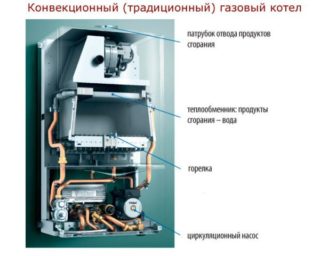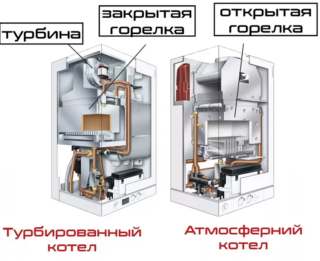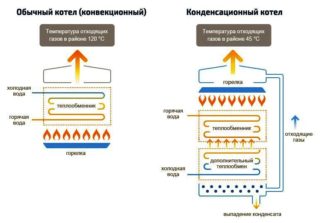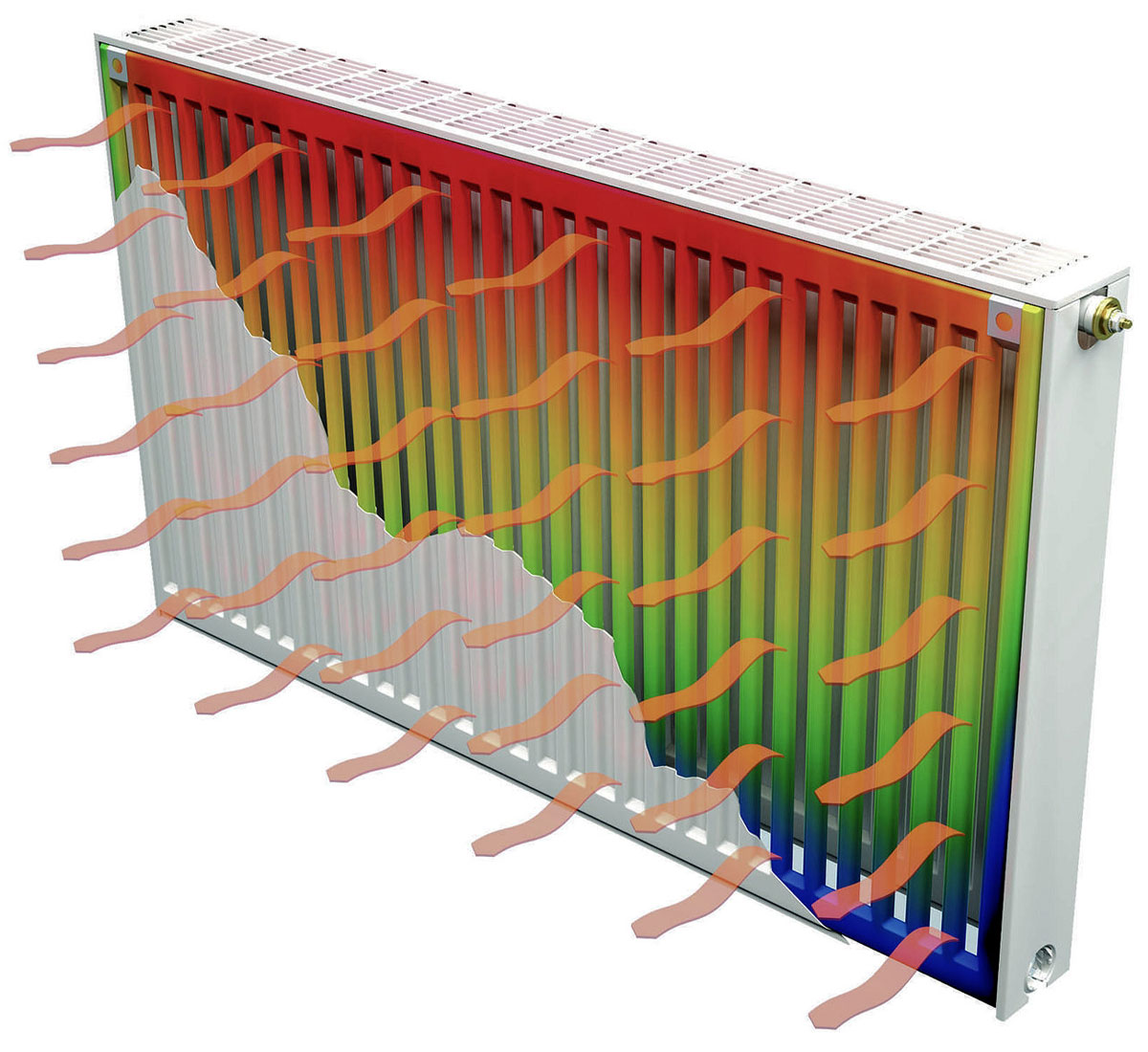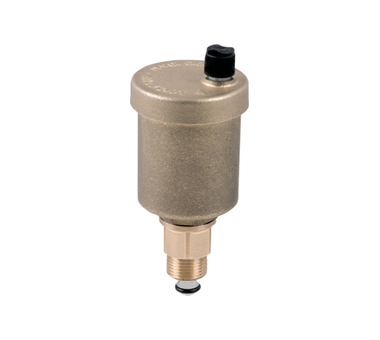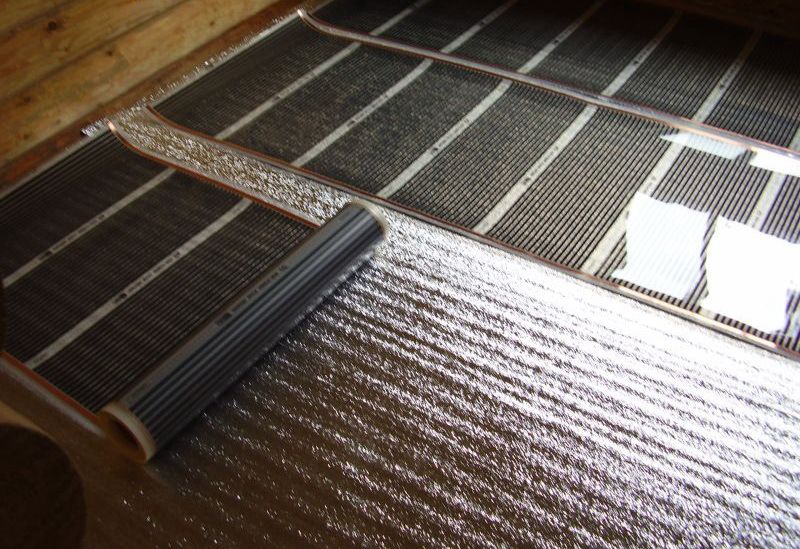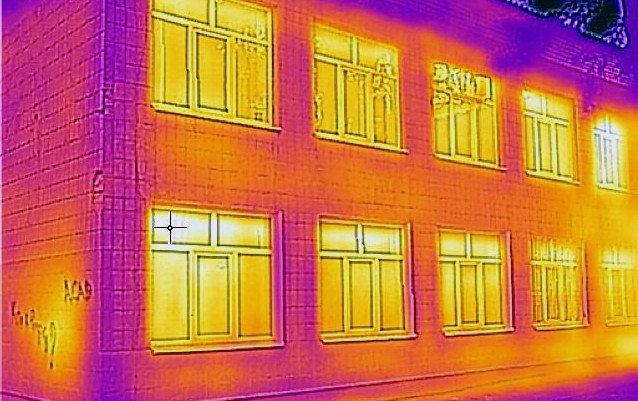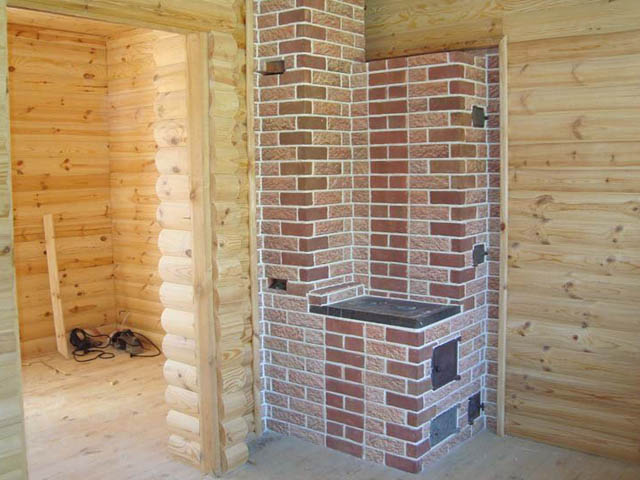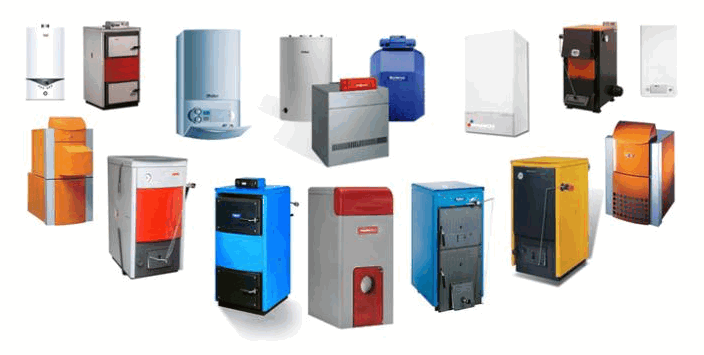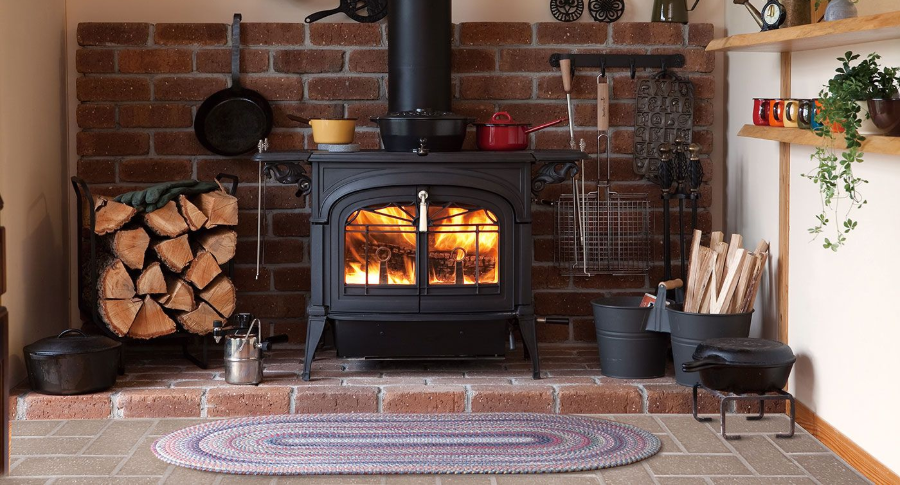The gas convection boiler belongs to the standard type of heating equipment. The unit heats the room, water for domestic and household needs. The smoke is removed through the chimney after the initial combustion of the fuel, the high temperature in the furnace prevents condensation from forming on the inside of the boiler. Powerful equipment requires forced air supply and removal of combustion products, since liquefied and natural gas are explosive substances.
Device and principle of operation
The work begins with the gas supply and the actuation of the piezoelectric ignition element. The spark ignites the igniter, which burns all the time of operation, the attenuation of the device threatens with an explosion. The base burner is switched on from the igniter, which heats the energy carrier to the required temperature. The automation turns off the main burner when the indicator is reached, and a drop in the value leads to the re-ignition of the flame.
The burner and heat exchanger determine the type of boiler. The first element is made of stainless steel, and regenerators and recuperators are made of materials:
- stainless steel;
- copper;
- carbon steel.
The disadvantage of the convection method is the wasteful use of heat. If you set the low temperature mode, the cooling of the end products leads to the formation of condensation in the chimney.
Types of convection boilers
Chimney used:
- separate type;
- coaxial option.
Natural draft involves the intake of oxygen from the room where the boiler is located, and the removal of combustion products without the use of fans.
Depending on the number of connected heating branches, boilers are:
- single-circuit;
- double-circuit.
The choice of the type of boiler depends on the needs of the house and the existing heating equipment. If there is a central hot water main, a single-circuit boiler is installed. The double-circuit unit works in such a way that while it heats the liquid in the water supply, the energy carrier in the system cools down. Such a boiler cannot cope with heating and heating the liquid at the same time if the demand for hot water is large.
Ukrainian manufacturers produce double-circuit equipment, in which an additional circuit is in the form of a coil and is located around the heat exchanger. This type of water heating is not automatically controlled, and hot liquid is obtained only during the heating season.
Single-circuit
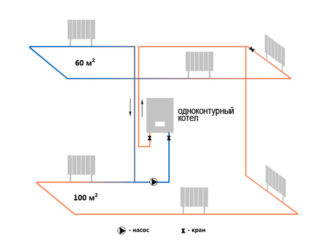
This type is used only for heating the room, and if you need to get hot water, a capacitive indirect water heater is connected. A gas convection boiler heats the building by heating the energy carrier in a heat exchanger. The heated liquid enters the piping and battery system, gives off heat and returns along the branch to the regenerator. The heating and advancement of water in the heating main is repeated.
Radiators are installed in series, while pipes are saved. The first batteries on the way of the energy carrier get hotter, the latter do not receive the required heat. In the end radiators, the number of sections is increased in order to increase heating. Sometimes control fittings are installed on the first heating devices to limit the temperature.
The movement of the energy carrier occurs due to the difference in pressure in the hot and cold state. The second option involves the use of a circulating pump.
Double-circuit
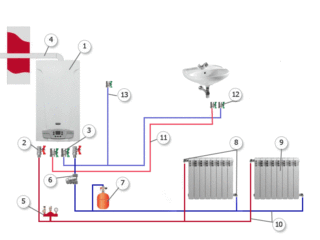
In this version, a heating branch and a hot water circuit are connected. The heating line forms a closed system, during which the hot liquid does not enter the water supply system. When the water supply is opened, a valve is triggered, which directs water to the hot water system, but blocks the flow of the coolant to the heating circuit. After closing the tap, the valve switches, water enters the heating system.
A combustion chamber is used in a double-circuit boiler:
- open;
- closed.
In a unit with an open chamber, air is naturally blown from the boiler room. In other rooms, the equipment is not installed, because if there is insufficient ventilation in the room, there is a lack of oxygen and the accumulation of combustion products. These boilers cost less and are used where there are separate boiler rooms.
In boilers with a closed chamber, air is supplied and removed forcibly, so there is no danger of smoke in the room. A storage boiler works better with a boiler than a flow boiler if the pressure in the water supply weakens or disappears. The cost of a unit with a boiler is higher than similar equipment with a flow-through type of liquid heating.
Installation methods

The floor or wall version is selected depending on the power and the heated area. Wall-mounted units provide heating of a room no more than 200 m2 and have a capacity of no more than 14 l / min. If the needs of the building are higher, a floor-standing unit is installed.
Floor
The equipment is mounted on the floor or on a special foundation, and the piping elements are purchased separately from the boiler.
Types of units are produced:
- fire tube steel boilers;
- gas cast iron equipment.
The first type has increased power and high efficiency. The heat exchanger is made in the form of a cylinder with a welded joint, it contains steel collectors for the movement of water. The gas combustion chamber receives the prepared gas-air composition from the blast burner.
Cast iron equipment is more often produced with sectional heat exchangers, and has blast or tubular burners. The power of the boilers is average, the weight is much lower than that of fire tube boilers. A cast iron heat exchanger serves for a long time subject to a certain temperature regime. For installation, the first and second type of boilers are delivered disassembled due to their significant weight.
Floor-standing units are chosen if it is required to heat several detached buildings or a large room, even if the total heating area does not exceed 200 m2.
Wall
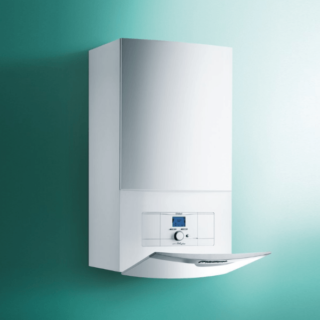
Suspended gas convection boiler is mounted on a vertical fence or a metal frame is welded for it. The heat exchanger is made of steel or copper, the burners are often tubular. Wall-mounted equipment is compactly placed in the room, boilers are sold with all the necessary elements and piping details.The sales set is a kind of boiler unit with remote control.
The wall-mounted version with an open camera is not often bought, although it is cheaper and does not depend on the supply of electricity. Closed wall-mounted boilers are purchased more often, popular models are compact and have an attractive appearance. Manufacturers use advanced technologies, the equipment is equipped with modern electronic filling. This can be a disadvantage as the electronics cannot withstand voltage surges and depend on the mains supply.
Wall-hung boilers are sensitive to the quality of the energy carrier. The liquid is heated in a small body with thin-walled internals. Poor quality water in the system leads to sedimentation. Antifreeze also does not apply to all wall-mounted units, as there is an instruction in the technical data sheet.
Advantages and disadvantages
The advantage of the convection gas boiler is simple design and low cost. Inexpensive materials are used as no condensation and metal corrosion. Convectors have the ability to reduce the cost of the system of intake and removal of combustion products through the use of natural draft.
The inefficiency of convection gas units is combined with the following advantages:
- the equipment is available for wall and floor type;
- some models have a cast iron heat exchanger that lasts a long time;
- condensate formed during operation goes into the pipe and does not affect the insides;
- easily assembled and repaired;
- some models do not use electricity;
- works silently;
- on sale a large selection of double-circuit and single-circuit options.
The downside is that the heating system is designed taking into account the temperature of the energy carrier at the outlet, which should not be less than + 57 ° C, otherwise liquid drops appear on the stacks of the heat exchanger, furnace and chimney, violating the integrity of the elements.
Comparison with a condensing boiler
Condensing models have additional heat exchange and condensation chambers called economizers. The compartments are made of metal, which is difficult to corrode, since the walls are in contact with the liquid. In convection units, heat is obtained only through the combustion of gas, and heat from condensation is not used.
Condensing units generate 20% more heat than traditional models when burning the same volume of fuel. The efficiency of equipment of the first type reaches 95 - 100%, and convection types show 82 - 86%.
For condensing boilers, a special line design is required in order to cool the energy carrier to a low temperature. Massive and expensive radiators are used, and if the liquid does not cool, the system with the unit will work with an efficiency lower than that stated in the passport. The equipment is not manufactured with open type fireboxes.
Equipment selection
The power of the boiler is determined at the rate of 100 W per 1 m2 of the room. The indicator can grow up to 150 W, depending on the heating of neighboring rooms, the height of the ceilings and the area of window openings. The figure is multiplied by the area of the room and the calculated power is obtained.
The type of ignition of the unit matters. Piezo ignition works by pressing a key and does not depend on electricity. Lack of additional fuel consumption for a burning igniter and dependence on the flow of gas from the main. An electric igniter is more economical; there are models that turn on automatically after a power outage.
Boilers of Korean manufacturers combine quality, reliability, low cost and adapt to gas pressure surges.The downside is the problem of finding spare parts during repairs, as well as the lack of service shops.

